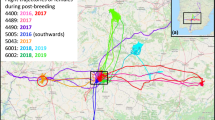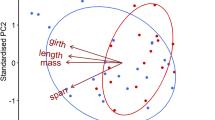Abstract
Breeding chronology, harem structure and changes in male harem dominance were studied at Stranger Point, Isla 25 de Mayo/King George Island, principally by extensive field census work during the 2003 breeding season. Males were individually identified and their size estimated by using a photogrammetric method. Peak female haul out for the population occurred on 31 October, when a total of 276 females were observed along 7 km of coastline, distributed in ten harems with a median size of 16 females. Overall sex ratio and harem sex ratio for the breeding population were 1:6.7 and 1:10.6, respectively. A total of 33 males were identified associated with harems. Male size conferred an advantage in terms of dominance hierarchy, since dominant males (4.91±0.15 m) were significantly longer than subordinate males (4.63±0.19 m). Harems were dominated by an average of 4.5 (range 2–7) different males during the breeding season. Elephant seals at Stranger Point breed in very low density aggregations. The main breeding events in this population occurred later than at other breeding sites, which agrees with previous observations in the area. Male movement among harems suggests that differences in mating success among males could be achieved through their different behaviours.




Similar content being viewed by others
Reference
Boyd IL (1991) Environmental and physiological factors controlling the reproductive cycles of pinnipeds. Can J Zool 69:1135–1148
Baldi R, Campagna C, Pedraza S, Le Boeuf B (1996) Social effects of space availability on the breeding behaviour of elephant seals in Patagonia. Anim Behav 51:717–724
Bell CM, Hindell MA, Burton HR (1997) Estimation of body mass in the southern elephant seal, Mirounga leonina, by photogrammetry and morphometrics. Mar Mamm Sci 13:669–682
Bester MN, Lenglart PY (1982) An analysis of the southern elephant seal (Mirounga leonina) breeding population at Kerguelen. Afr J Antarct Res 12:11–16
Burton HR, Arnbom T, Boyd IL, Bester M, Vergani D, Wilkinson I (1997) Significant differences in weaning mass of southern elephant seals from five sub-Antarctic islands in relation to population declines. In: Battaglia B, Valencia J, Walton DWH (eds) Antarctic communities: species, structure and survival. Cambridge University Press, Cambridge, pp 335–338
Campagna C, Lewis M (1992) Growth and distribution of a southern elephant seal colony. Mar Mamm Sci 8:387–396
Campagna C, Lewis M, Baldi R (1993) Breeding biology of southern elephant seals in Patagonia. Mar Mamm Sci 9:34–47
Carlini AR, Daneri GA, Márquez MEI, Soave G, Poljak S (1997) Mass transfer from mothers to pups and mass recovery during the post-breeding foraging period in southern elephant seals (Mirounga leonina) at King George Island. Polar Biol 18:305–310
Carlini AR, Poljak S, Daneri GA, Márquez MEI, Plötz J (2002) Dynamics of male dominance of southern elephant seals (Mirounga leonina) during the breeding season at King George Island. Pol Polar Res 23:153–159
Carrick R, Csordas SE, Ingham SE (1962) Studies on southern elephant seal, Mirounga leonina (L.). IV Breeding and development. CSIRO Wildl Res 7:161–197
Clinton WL (1990) Sexual selection and the life history of male northern elephant seals. PhD Thesis, University of California, Santa Cruz
Fabiani A, Galimberti F, Sanvito S, Hoelzel R (2004) Extreme polygyny among southern elephant seals on sea Lion Island, Falkland Islands. Behav Ecol 15:961–969
Galimberti F, Boitani L (1999) Demography and breeding biology of a small, localised population of southern elephant seals (Mirounga leonina). Mar Mamm Sci 15:159–178
Gibbney LE (1957) The seasonal reproductive cycle of the female elephant seal, Mirounga leonina Linn., at Heard Island. A.N.A.R.E. report (B), pp 1–26
Haley MP, Deutsch CJ, Le Boeuf BJ (1991) A method for estimating mass of large pinnipeds. Mar Mamm Sci 7:157–154
Haley MP, Deutsch CJ, Le Boeuf BJ (1994) Size, dominace and copulatory success in male northern elephant seals, Mirounga angustirostris. Anim Behav 48:1249–1260
Hoelzel AR, Le Boeuf BJ, Reiter J, Campagna C (1999) Alpha-male paterniy in elephant seals. Behav Ecol Sociobiol 46:298–306
Hoelzel AR, Campagna C,Arnbom T (2001) Genetic and morphometric differentiation between island and mainland southern elephant seal populations. Proc R Soc Lond Biol Sci 268:325–332
Kirkman SP, Bester MN, Hofmeyr GJG, Jonker FC, Pistorius PA, Owen R, Strydom N (2004) Variation in the timing of the breeding haulout of female southern elephant seals at Marion Island. Aust J Zool 52:379–388
Laws RM (1953) The elephant seal (Mirounga leonina Linn.) at South Georgia. I Growth and age. Scientific reports of the Falkland Islands dependecies survey, vol 8, pp 1–62
Laws RM (1994) History and present status of the southern elephant seal populations. In: Le Boeuf BJ, Laws RM (eds) Elephant seals, population ecology, behavior and physiology. University of California Press, Berkeley, pp 49–65
Le Boeuf BJ (1974) Male-male competition and reproductive success in elephant seals. Am Zool 14:163–176
Le Boeuf BJ, Reiter J (1988) Lifetime reproductive success in northern elephant seals. In: Clutton-Brock TH (ed) Reproductive success. University of Chicago Press, Chicago, pp 344–362
McCann TS (1980) Population structure and social organisation of Southern elephant seals, Mirounga leonina (L.). Biol J Linn Soc 14:133–150
McCann TS (1981) Aggression and sexual activity of male southern elephant seals, Mirounga leonina. J Zool Lond 195:295–310
McCann TS (1982) Agressive and maternal activities of female southern elephant seals, Mirounga leonina. Anim Behav 29:670–678
McMahon C, Bester MN, Burton HR, Hindell MH, Bradshaw W (2005) Population status, trends and a re-examination of the hypotesis explaning the recent declines of the Southern elephant Mirounga leonina. Mamm Rev 35:82–100
McMahon CR, Bradshaw CJA (2004) Harem choice and breeding experience of female southern elephant seals influence offpring survival. Behav Ecol Sociobiol 55:349–362
McMahon CR, Campbell D (2000) Southern elephant seals breeding at Peterson Island, Antarctica. Polar Rec 36(196):51
Modig AO (1996) Effects of body size and harem size on male reproductive behaviour in the southern elephant seal. Anim Behav 51:1295–1306
Pistorius PA, Bester MN, Kirkman SP, Taylor FE (2001) Pup mortality in southern elephant seals at Marion Island. Polar Biol 24:823–831
Slade RW, Moritz C, Hoelzel AR, Burton HR (1998) Molecular population genetics of the southern elephant seals, Mirounga leonina. Genetics 149:1945–1957
SCAR (2000) Report of the 26th meeting of the SCAR Group of specialists on seals, Tokyo, Japan
Van Aarde RJ (1980) Fluctuations in the population of southern elephant seals (Mirounga leonina) at Kerguelen Island. S Afr J Zool 15:99–106
Vergani DF (1985) Estudio comparativo de las poblaciones de Antártida y Patagonia del elefante marino del sur Mirounga leonina (Linne, 1758) y su metodología. Publicación Nro 15, Instituto Antártico Argentino, p 94
Vergani DF, Lewis MN, Stanganelli ZB (1987) Observation on haul out patterns and trends of the breeding populations of southern elephant seals at Península Valdés (Patagonia) and Stranger Point (25 de Mayo-King George Island), SC-CCAMLR-VI/BG, vol 36. Hobart, Tasmania, pp 1–9
Vergani DF, Stanganelli ZB (1990) Fluctuations in breeding populations of elephant seals Mirounga leonina at Stranger Point, King George Island 1980–1988. In: Hempel K (ed) Antarctic ecology. Environmental changes and conservation. Springer, Berlin Heidelberg New York, pp 241–245
Wilkinson IS, van Aarde RJ (1999) Marion Island elephant seals: the paucity-of-males hypothesis tested. Can J Zool 77:1547–1554
Acknowledgements
We want to thank Lic. Esteban Soibelzon, Prof. Miguel Gasco and Leandro Balboni for field assistance. Our procedures conform to the Code of Ethics of Animal Experimentation in Antarctica. We also thank N. de Bruyn an one anonymous reviewer for helpful comments to improve the manuscript. The permit for this work was granted by the Dirección Nacional del Antártico (Environmental Office), Argentina. This work was funded by the Dirección Nacional del Antártico and the Secretaría de Ciencia y Técnica (Picto:11559).
Author information
Authors and Affiliations
Corresponding author
Rights and permissions
About this article
Cite this article
Carlini, A.R., Poljak, S., Daneri, G.A. et al. The dynamics of male harem dominance in southern elephant seals (Mirounga leonina) at the South Shetland Islands. Polar Biol 29, 796–805 (2006). https://doi.org/10.1007/s00300-006-0117-6
Received:
Revised:
Accepted:
Published:
Issue Date:
DOI: https://doi.org/10.1007/s00300-006-0117-6




